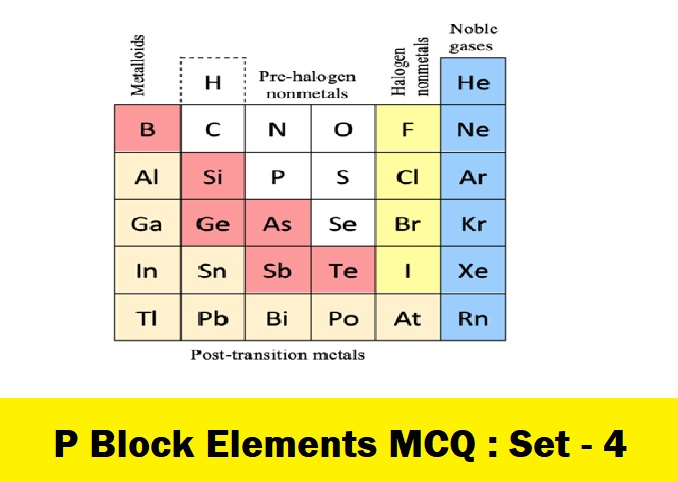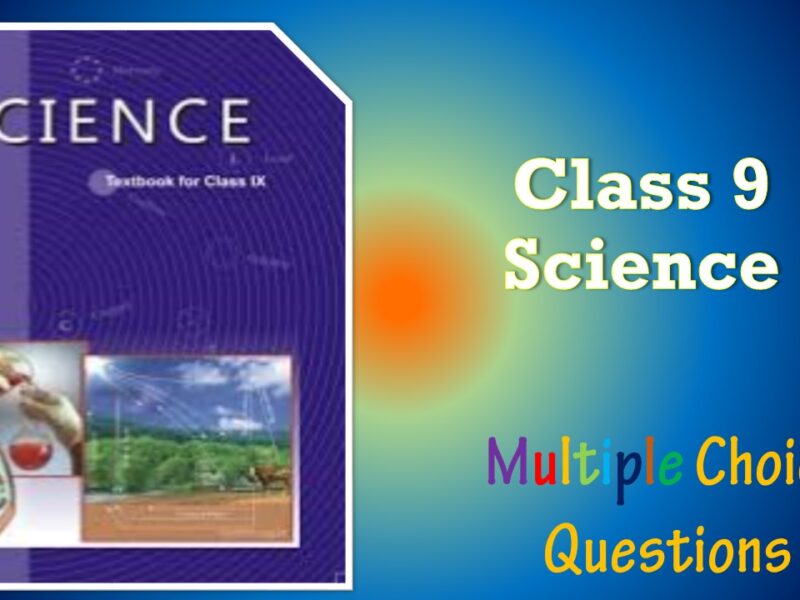CBSE Class 11 Chemistry Chapter 11 The p Block Elements Multiple Choice Questions with Answers. MCQ Questions Class 11 Chemistry The p Block Elements with Answers was Prepared Based on Latest Exam Pattern. Students can solve NCERT Class 11 Chemistry The p Block Elements MCQs with Answers to know their preparation level.
Students who are searching for NCERT MCQ Questions for Class 11 Chemistry The p Block Elements with Answers are compiled here to get good practice on all fundamentals. Know your preparation level on MCQ Questions for Class 11 Chemistry with Answers. You can also verify your answers from our provided MCQ Class 11 Chemistry The p Block Elements with Answers. So, ace up your preparation with MCQ of Chapter 11 Chemistry Objective Questions.
MCQ Questions Class 11 Chemistry The p Block Elements with Answers - Set - 4
Question 1:
Question. Thallium shows different oxidation states because
(a) it is transition element
(b) of inert pair effect
(c) of its amphoteric character
(d) of its higher reactivity
Correct Answer – (B)
Question 2 :
Question. Which of the following does not form M3+ ion?
(a) Boron
(b) Aluminium
(c) Indium
(d) Gallium
Correct Answer – (A)
Question 3 :
Question. Which of the following is most abundant in the earth crust ?
(a) Boron
(b) Aluminium
(c) Gallium
(d) Thallium
Correct Answer – (B)
Question 4 :
Question. Which of the following properties of aluminium makes it useful for food packaging ?
(a) Good electrical conductivity
(b) Good thermal conductivity
(c) Low density
(d) Non toxicity
Correct Answer – (C)
Question 5 :
Question. The non-metal oxides are ____x____ whereas metal oxides are ___y ____ in nature.
(a) x = acidic or neutral, y = basic
(b) x = acidic, y = neutral
(c) x = basic, y = acidic
(d) x = neutral, y = basic
Correct Answer – (A)
MCQ Questions Class 11 Chemistry The p Block Elements with Answers
Question 6 :
Question. The group 13 element that is liquid during summer and used for measuring high temperature is
(a) Boron
(b) Aluminium
(c) Gallium
(d) Indium
Correct Answer – (C)
Question 7 :
Question. Ionisation enthalpy (ΔiH1kJ mol–1) for the elements of Group 13 follows the order.
(a) B > Al > Ga > In > Tl
(b) B < Al < Ga < In < Tl
(c) B < Al > Ga < In > Tl
(d) B > Al < Ga > In < Tl
Correct Answer – (D)
Question 8 :
Question. Which of the following is/are true regarding gallium?
(i) It has unusually low melting point (303 K).
(ii) It exist in liquid state during summer.
(iii) It has a high boiling point (2676 K).
The correct option is
(a) (i) and (ii)
(b) (i) and (iii)
(c) (i), (ii) and (iii)
(d) (ii) and (iii)
Correct Answer – (C)
Question 9 :
Question. The relationship between first, second and third ionisation enthalpies of each group-13 element is
(a) ΔiH1 > ΔiH2 > ΔiH3
(b) ΔiH1 < ΔiH2 < ΔiH3
(c) ΔiH1 = ΔiH2 > ΔiH3
(d) ΔiH3 > ΔiH1 > ΔiH2
Correct Answer – (B)
Question 10 :
Question. Which of the following compounds is used in cosmetic surgery?
(a) Silica
(b) Silicates
(c) Silicones
(d) Zeolites
Correct Answer – (C)
- NCERT Solutions Class 11 Chemistry Chapter 1 : Some Basic Concepts of Chemistry
- NCERT Solutions Class 11 Chemistry Chapter 2 : Structure Of The Atom
- NCERT Solutions Class 11 Chemistry Chapter 3 : Classification of Elements and Periodicity in Properties
- NCERT Solutions Class 11 Chemistry Chapter 4 : Chemical Bonding and Molecular Structure
- NCERT Solutions Class 11 Chemistry Chapter 5 : States of Matter
- NCERT Solutions Class 11 Chemistry Chapter 6 : Thermodynamics
- NCERT Solutions Class 11 Chemistry Chapter 7 : Equilibrium
- NCERT Solutions Class 11 Chemistry Chapter 8 : Redox Reactions
- NCERT Solutions Class 11 Chemistry Chapter 9 : Hydrogen
- NCERT Solutions Class 11 Chemistry Chapter 10 : The s-Block Elements
- NCERT Solutions Class 11 Chemistry Chapter 11 : The p-Block Elements
- NCERT Solutions Class 11 Chemistry Chapter 12 : Organic Chemistry: Some Basic Principles and Techniques
- NCERT Solutions Class 11 Chemistry Chapter 13 : Hydrocarbons
- NCERT Solutions Class 11 Chemistry Chapter 14 : Environmental Chemistry



